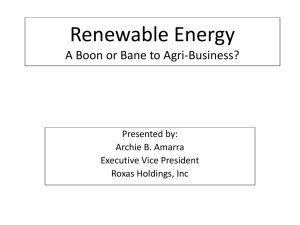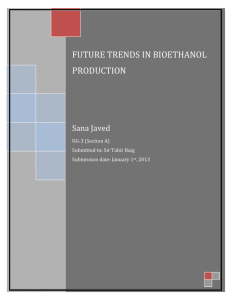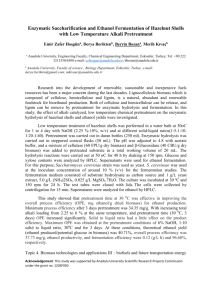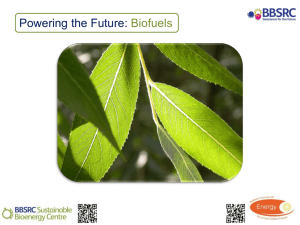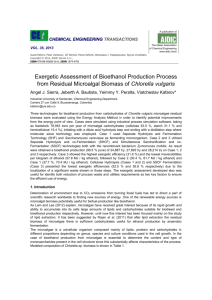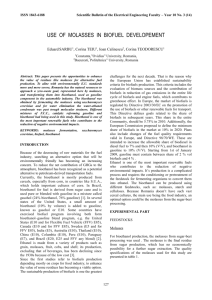Future trends of bioethanol production(Article) - ASAB-NUST
advertisement
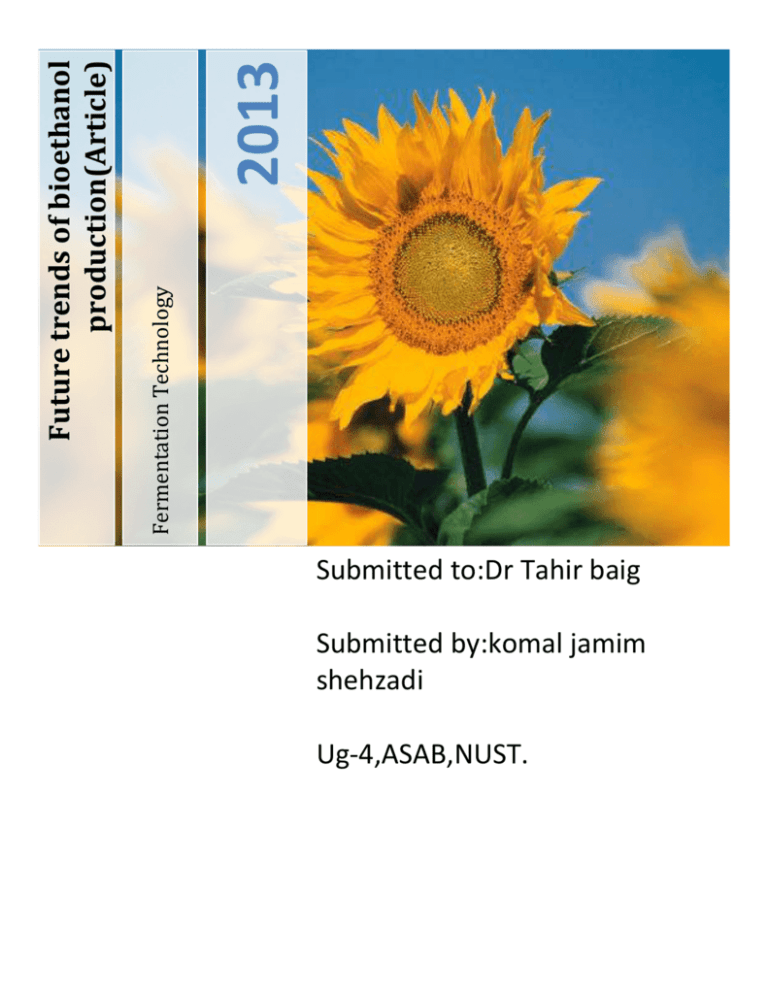
2013 Future trends of bioethanol production(Article) Fermentation Technology Submitted to:Dr Tahir baig Submitted by:komal jamim shehzadi Ug-4,ASAB,NUST. FUTURE TRENDS OF BIOETHANOL PRODUCTION J.s.komal,Atta-ur-Rehman school of Applied biosciences,National university of sciences and technology,Islamabad,Pakistan. ABSTRACT Petroleum reserves of the world are depleting day by day due to its extensive use.To accomplish the needs of the present age it is necessary to replace the petroleum with other fuel like ethanol.Bioethanol is produced by using biomass from different sources .There are different methods and bioreactors are developed for bioethanol production which have promising future.Agricultural land is also reducing due to different man activities,people are scared that it might be result into the reduction of food for mankind and animlas ,therefore different methods have been developed by using genetic engineering to increase the biomass production from energetic crops so that large amount of biomass is produced using small portion of the land by hybrid crops.Different techniques are also developed like ,protein ,metabolic pathway engineering of the microbes,ultrasonic processing, and halophytes and e-diesl development. Introduction Nowadays fermentation is playing a main role in every industry e.g.medicine, dairy etc. Likewise Bio ethanol is also a product of fermentation. It is a principle fuel used as petrol substitute. Because Ethanol has greater octane octane number and it has replaced lead which is used as octane enhancer in petrol.The common mixture is made by mixing 90% petrol and 10% ethanol. Bio ethanol is alternative to petrol and other fuels for flexi fuel vehicles. It is alcohol produced by fermentation of the carbohydrates produced in sugars or starch crops such as corn and sugarcane. Cellulosic biomass ,obtained from non-food sources e.g, grasses and trees, is also being developed as feedstock for ethanol production. Biomass is widely used for bioethanol production. Biomass is a renewable energy source, which is derived from biological material from living or recently living organisms. As energy source biomass can be used as it is, or changed into other energy source such as biofuel. Its major components are carbon hydrogen and oxygen .Biomass energy is obtained from five different main sources. These sources are waste, garbage, and wood, alcohol fuels, and landfill gases. Other sources are rice mills, bagasses, sugar, rice husk, fruit shells ,palm oil mills, Fruits shells, Empty fruits bunch, Wood based industries, Other agricultural residues. PRODUCTION It can be made by different sources such as potatoes, ,switch grass,sugar beet, sugar cane, molasses corn,fruits, Stover, straw ,wheat,other biomass , many types of cellulose waste as well as reaping. Agriculture feedstock considered as renewable because they use solar energy and food producing mechanism of plant. Fig: Equipments used in bioethanol production Material and method These are generalized steps for bioethanol production by any source of biomass. First of all the size of the biomass is reduced to make is feasible for handling as well as to increase the efficacy of production process .e.g. agriculture residues go through grindins process and wood go through whittle process to achieve similar particle size. In the second step biomass is broken down into simple sugars,biomass is mixed with dilute sulfuric acid and a chemical reaction hydrolysis take place.In this type of reaction multiplex and heavy chains of the carbohydrates broken down into simpler sugars.These complex sugars are converted into mixture of arabinose,xylose,mannose,and galactose.Cellulose is also converted into glucose. Enzymes are produced in third step .Enzymes can also purchased from commercial enzyme markets. The next step is cellulose saccharification, in this enzymatic hydrolysis remaining cellulose is converted into glucose by using cellulase. In this step ethanol is produced by fermentation.It is a series of reaction caused by microbes e.g,bacteria or yeast which uses sugars as a food.As microbes use sugars as a consequences carbon dioxide and ethanol produced. Hemicellulose fraction of biomass has plenty of pentoses in which xylose is the dominant one,in this step fermentation of xylose is take place by using genetically engineered bacteria zymomonas mobilis. Ethanol is recovered in this step,ethanol is disparated from other constituents of the broth,at the end dehydration removes the water from the ethanol. There are other by products are produced during ethanol production which can be used for different purposes e.g,electricity generation. Fig: Schematic diagram for bioethanol production Future horizon of bioethanol production Shortage of agricultural land leads to the advances in metabolical pathway engineering and genetic engineering of the different microbes.in which they Broadens the substrate range such as arabinose and xylose in strains e.g,Escheichia coli , streptomyces sp. And zymomonas mobilis. According to recent advances in fermentation technology cellulose and hemicellulose are efficiently deplymerize into simple sugars In lignocellulose to ethanol process .Pentose sugar is present in the lignocellulosic material which reduces the energy demand because it takes less time and energy to break the the five carbon sugars than complex one. Genetic Engineering of plants Genetic engineering of plants will also play important role in biofuel industry.By using genetic engineering tools and technology we can develop hybrid varities of energetic crops which will greatly increases the starch yield which in turn increases the biomass for ethanol production and also helps in economical gains an example of this is improved hybrid corn.Halophytes are also developed which are saline tolerant .It reduces the use of the agricultural land which is used for food production. Protein Engineering. If we modify the amino acid sequence of the enzyme or proteins we can enhance the efficiency of enzymatic hydrolysis. It will reduces the time as well as increases the efficiency of the reaction. Development of the oxygenated diesel It is also known as E-Diesel.It is produced by direct mixing of the bioethanol and diesel fuel.It has appreciating role in reducing particulate emission.Another advantage is that it has low production cost.But the obstacle in using this process is that ethyl alcohol is ordinarily immiscible with the diesel it requires surfactants to reduce the surface tension and proper mixing. Ultrasonic processing It has been Recently seen that ultrasonic processing used in biodiesel production increases a biodiesel yield in excess of 99% in five minutes or less.While in conventional batch reactor systems it take an hour or more. Hurdles In using bioethanol and thrash to the problem Along with the benefits there are also drawbacks associated with the ethyl alcohol . The major hurdles in using ethyl alcohol as transport fules are,it picks up water with it ,it is also corrosive ,it is volatile and has low energy density.This problem can be overcome by replacing ethanol with other alcohol such as butanol.Butanol has four carbon atoms in its structure and has lower volatility rate and increased energy density which can be used as efficient transport fuel.US has produced butanol experimentally by using sugar beet and cellulosic feedstock. Results Bioethanol comes from renewable resources. It is biodegradeable and far less poisonous than fossil fuels.It has Benefit over fossil fuel is that it cause reuction in greenhouse gas emissions. Bioethanol can be easily homogenized into existing road transport fuel system.Mixing of bioethanol with petrol will ensure greater fuel securety avoiding heavy reliance on oil producing nations. Conclusion Research and development of new strains and modification in their different metabolic pathways will tremendously increase the fermentation of bioethanol. New designs of bioreactors will also play an important role in bioethanol production. It is a need to discover High yielding process to make bioethanol ruthless with other fuels such as biodiesel in the future. A growing ethanol industry will provide jobs in plant operations and maintenance and contribute to rural economic development. Refrences 1)Institute of Sustainable Halophyte Utilization, University of Karachi, University Road, Karachi 75270, Pakistan 2)Graduate School of Life and Environmental Sciences, University of Tsukuba, 1-1-1 Tennodai, Tsukuba, Ibaraki, Japan 3) Food Engineering Research Division, National Food Research Institute, 2-1-12 Kannondai, Tsukuba, Ibaraki, Japan 4) Graduate School of Agriculture, Hokkaido University, Kita 9, Nishi 9, Kita-ku, Sapporo, Hokkaido, Japan



